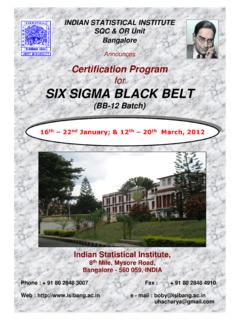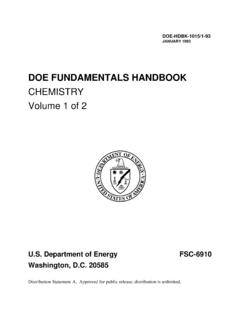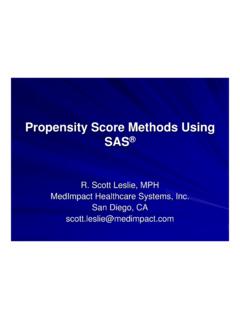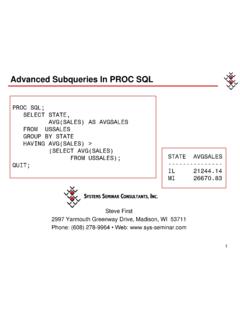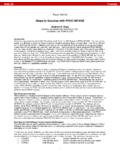Transcription of Applied Statistics Handbook - Indian Statistical Institute
1 ExampleApplied Statistics Handbook Phil Crewson Version Applied Statistics Handbook Copyright 2006, AcaStat Software. All rights Reserved. Protected under Copyright and international of Contents PREFACE .. 5 APPROACH USED IN THIS 5 SOFTWARE EXAMPLES .. 6 CHAPTER 1: INTRODUCTION .. 6 RESEARCH 6 Overview of first four elements of the Scientific 7 Levels of Data .. 9 Association .. 10 Reliability and Validity .. 11 Study Design .. 11 REPORTING RESULTS .. 12 Paper Format .. 13 Table Format .. 15 Critical Review Checklist .. 16 HYPOTHESIS TESTING BASICS .. 17 The Normal 19 Steps to Hypothesis 22 CHAPTER 2: NOMINAL/ORDINAL DATA .. 23 UNIVARIATE DESCRIPTIVE Statistics .. 24 Ratios .. 24 Rates .. 24 Proportions .. 24 BIVARIATE DESCRIPTIVE 26 Interpreting Contingency Tables .. 26 Summary Table.
2 28 INFERENCE USING 29 Interval Estimation for Proportions (Margin of Error) .. 30 ExampleInterval Estimation for the Difference Between Two Proportions .. 35 Comparing a Population Proportion to a Sample Proportion (Z-test) .. 36 Comparing Proportions From Two Independent Samples .. 39 Appropriate Sample 42 INFERENCE USING COUNTS .. 43 Chi-Square Goodness-of-Fit Test .. 44 Chi-Square Test of Independence .. 46 Standardized Residuals .. 49 Coefficients for Measuring Association .. 50 CHAPTER 3: INTERVAL/RATIO 55 UNIVARIATE DESCRIPTIVE Statistics .. 56 Measures of Central Tendency .. 56 Measures of Variation .. 58 Standardized 60 INFERENCE USING MEANS .. 63 Interval Estimation For Means (Margin of Error) .. 64 Comparing a Population Mean to a Sample Mean (T-test) .. 67 Comparing Two Independent Sample Means (T-test).. 70 Computing 73 Two Independent Sample Means (Cochran and Cox).
3 75 One-Way Analysis of Variance (ANOVA).. 79 Multiple Comparison Problem .. 83 COMPARING TWO INTERVAL/RATIO VARIABLES .. 85 Pearson's Product Moment Correlation 85 Hypothesis Testing for Pearson r .. 88 Spearman Rho Coefficient .. 91 Hypothesis Testing for Spearman 93 Simple Linear Regression .. 95 CHAPTER 4: MULTIVARIATE 103 MULTIPLE 103 MULTIPLE REGRESSION 113 LOGISTIC MULTIPLE REGRESSION .. 123 TABLES .. 126 Z DISTRIBUTION CRITICAL VALUES .. 127 T DISTRIBUTION CRITICAL VALUES (2-TAILED) .. 128 CHI-SQUARE DISTRIBUTION CRITICAL VALUES .. 129 F DISTRIBUTION CRITICAL VALUES .. 130 APPENDIX ..131 DATA FILES 132 BASIC 137 GLOSSARY OF TERMS .. 138 ORDER OF MATHEMATICAL 139 DEFINITIONS .. 140 INDEX .. 158 ExamplePreface Approach Used in this Handbook The Applied Statistics Handbook was developed to serve as a quick reference for undergraduate and graduate liberal arts students taking research methods courses.
4 The Handbook augments classroom lecture and commonly available Statistical texts by providing an easy to follow outline for conducting and interpreting data analysis and hypothesis tests. It was not designed as a stand-alone Statistical text, although some may wish to use it concurrently with a comprehensive lecture series. The approach of this Handbook is to present commonly used steps and formulas in Statistics , provide an example of how to conduct the calculations by hand, and then an example of software output. The software output has annotated interpretations. This approach connects classically taught Statistics with Statistical software output. The output is very similar to SAS, SPSS, and other common Statistical software, so skills learned with the Handbook are transferable to almost any Statistical software to include the analysis module available in Microsoft Excel.
5 AcaStat Software AcaStat is an easy to use Statistical software system that provides modules for analyzing raw (electronic data not aggregated) and summary data (multiple records reduced to counts, means, proportions, etc.). Most of the software output presented in the Handbook was created with AcaStat. Student Workbook The Handbook works well with the Student Workbook. The Workbook includes examples and practical exercises designed to teach Applied analytical skills. It is designed to work with AcaStat software but can also be used with other Statistical software packages. The Workbook is a free download from Example Software Examples The following symbols are used to indicate which software is most appropriate for the examples presented. AcaStat Software: Used for raw data (StatProcs and Data Grid) or summary data (SumStats).
6 Spreadsheet Template: A spreadsheet for Excel ( ) and OpenOffice Calc ( ) duplicates the SumStat module available in AcaStat. If you do not use AcaStat, these templates can be used along with SPSS or another Statistical software package to produce the examples. OpenOffice is a free download from Microsoft Excel: Excel provides data analysis tools to conduct Statistical analyses to include descriptives, t-tests, ANOVA, correlation, and regression. To access these tools, open Excel and use the Tools pull-down menu to select Add Ins/Data Analysis. Although it is also possible to replicate frequency and crosstabulation procedures using Excel s Pivot Tables, considerable practice is needed to master their use, so the Handbook recommends AcaStat or SPSS instead of Excel for these type of analyses. Statistical Software: The SPSS icon is used to represent all off-the-shelf Statistical software such as SAS, STATA, Minitab, etc.
7 These commercially available packages analyze raw data. Example Univariate Descriptive Statistics Measures of Central Tendency Mode: The most frequently occurring score. A distribution of scores can be unimodal (one score occurred most frequently), bimodal (two scores tied for most frequently occurring), or multimodal. In the table below the mode is 32. If there were also two scores with the value of 60, we would have a bimodal distribution (32 and 60). Median: The point on a rank ordered list of scores below which 50% of the scores fall. It is especially useful as a measure of central tendency when there are very extreme scores in the distribution, such as would be the case if we had someone in the age distribution provided below who was 120. If the number of scores is odd, the median is the score located in the position represented by (n+1)/2.
8 In the table below the median is located in the 4th position (7+1)/2 and would be reported as a median of 42. If the number of scores are even, the median is the average of the two middle scores. As an example, if we dropped the last score (65) in the above table, the median would be represented by the average of the 3rd (6/2) and 4th score, or 37 (32+42)/2. Always remember to order the scores from low to high before determining the median. Variable Age Also known as X 24 32 Mode 32 42 Median Xi Each score 55 60 65 n= 7 Number of scores (or cases) = iX 310 Sum of scores =X Mean Example Mean.
9 The sum of the scores (iX ) is divided by the number of scores (n) to compute an arithmetic average of the scores in the distribution. The mean is the most often used measure of central tendency. It has two properties: 1) the sum of the deviations of the individual scores (Xi) from the mean is zero, 2) the sum of squared deviations from the mean is smaller than what can be obtained from any other value created to represent the central tendency of the distribution. In the above table the mean age is (310/7). Weighted Mean: When two or more means are combined to develop an aggregate mean, the influence of each mean must be weighted by the number of cases in its subgroup. 321332211nnnXnXnXnXw++++= Example 10,121==nX 15,142==nX 40,183==nX Wrong Method: () ++ Correct Method: () ()() ++++ Example Measures of Variation Range: The difference between the highest and lowest score (high-low).
10 It describes the span of scores but cannot be compared to distributions with a different number of observations. In the table below, the range is 41 (65-24). Variance: The average of the squared deviations between the individual scores and the mean. The larger the variance the more variability there is among the scores. When comparing two samples with the same unit of measurement (age), the variances are comparable even though the sample sizes may be different. Generally, however, smaller samples have greater variability among the scores than larger samples. The sample variance for the data in the table below is The formula is almost the same for estimating population variance. See formula in Appendix. Standard deviation: The square root of variance. It provides a representation of the variation among scores that is directly comparable to the raw scores.



